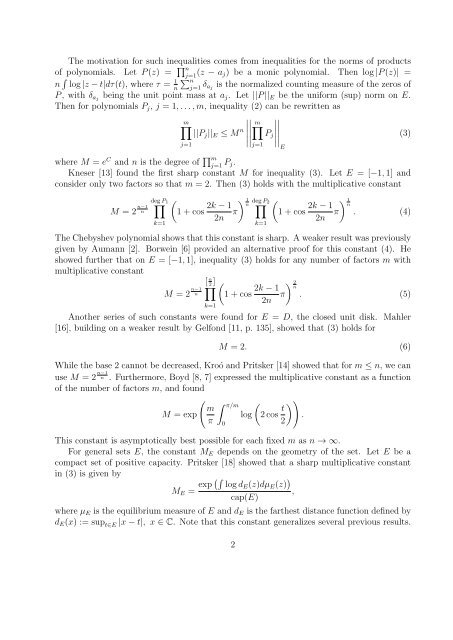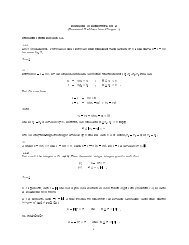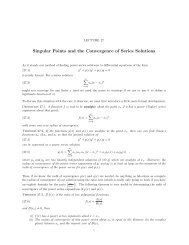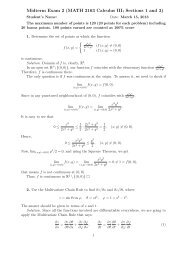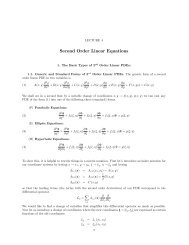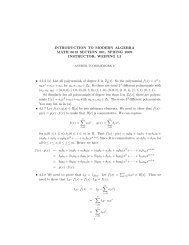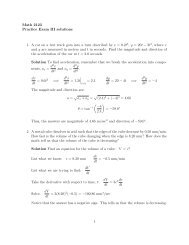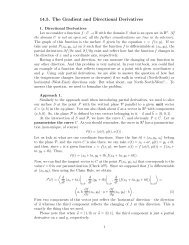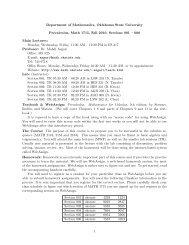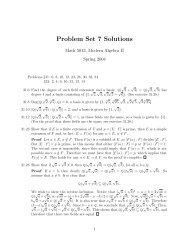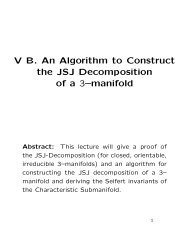The motivation <strong>for</strong> such inequalities comes from inequalities <strong>for</strong> the norms of productsof polynomials. Let P (z) = ∏ nj=1 (z − a j) be a monic polynomial. Then log |P (z)| =n ∫ ∑log |z − t|dτ(t), where τ = 1 nn j=1 δ a jis the normalized counting measure of the zeros ofP , with δ aj being the unit point mass at a j . Let ||P || E be the uni<strong>for</strong>m (sup) norm on E.Then <strong>for</strong> polynomials P j , j = 1, . . . , m, inequality (2) can be rewritten as∣∣ m∏∣∣∣∣ ∣∣∣∣ ∏ m||P j || E ≤ M nj=1j=1P j∣ ∣∣∣∣∣ ∣∣∣∣E(3)where M = e C <strong>and</strong> n is the degree of ∏ mj=1 P j.Kneser [13] found the first sharp constant M <strong>for</strong> inequality (3). Let E = [−1, 1] <strong>and</strong>consider only two factors so that m = 2. Then (3) holds with the multiplicative constantM = 2 n−1ndeg P∏ 1k=1(1 + cos 2k − 12n π ) 1deg P 2n ∏k=1(1 + cos 2k − 1 ) 12n π n. (4)The Chebyshev polynomial shows that this constant is sharp. A weaker result was previouslygiven by Aumann [2]. Borwein [6] provided an alternative proof <strong>for</strong> this constant (4). Heshowed further that on E = [−1, 1], inequality (3) holds <strong>for</strong> any number of factors m withmultiplicative constantM = 2 n−1n[ n 2∏]k=1(1 + cos 2k − 1 ) 22n π n. (5)Another series of such constants were found <strong>for</strong> E = D, the closed unit disk. Mahler[16], building on a weaker result by Gelfond [11, p. 135], showed that (3) holds <strong>for</strong>M = 2. (6)While the base 2 cannot be decreased, Kroó <strong>and</strong> Pritsker [14] showed that <strong>for</strong> m ≤ n, we canuse M = 2 n−1n . Furthermore, Boyd [8, 7] expressed the multiplicative constant as a functionof the number of factors m, <strong>and</strong> found( ∫m π/m(M = exp log 2 cos t π2) ) .0This constant is asymptotically best possible <strong>for</strong> each fixed m as n → ∞.For general sets E, the constant M E depends on the geometry of the set. Let E be acompact set of positive capacity. Pritsker [18] showed that a sharp multiplicative constantin (3) is given byM E = exp (∫ log d E (z)dµ E (z) ),cap(E)where µ E is the equilibrium measure of E <strong>and</strong> d E is the farthest distance function defined byd E (x) := sup t∈E |x − t|, x ∈ C. Note that this constant generalizes several previous results.2
We can calculate that M [−1,1] ≈ 3.20991, which is the asymptotic version of Borwein’s constantfrom (5) as n → ∞. For the closed unit disk, we obtain M D = 2, which is the constantgiven by Mahler (6). Furthermore, Pritsker <strong>and</strong> Ruscheweyh [20, 21] showed that M D is alower bound on M E <strong>for</strong> any compact E with positive capacity. They also conjectured thatM [−1,1] is an upper bound <strong>for</strong> all non-degenerate continua. Shortly afterward, Baernstein,Pritsker, <strong>and</strong> Laugesen [3] showed M [−1,1] is an upper bound <strong>for</strong> centrally symmetric continua.The assumption that E has positive capacity is vital. For example, if E is a finiteset, then no inequality of the <strong>for</strong>m (3) is possible <strong>for</strong> any number of factors m ≥ 2. If E iscountable, then the constant M could grow arbitrarily fast as m grows large.All results <strong>for</strong> M in (3) apply as well to C in (2) with C = log M, see [22]. Specifically,(2) holds with sharp additive constant∫C E = log d E (z)dµ E (z) − log cap(E).It follows from [20, 21] that C D = log 2 is a lower bound <strong>for</strong> C E <strong>for</strong> any compact set E withpositive capacity, while C [−1,1] ≈ log 3.20991 is an upper bound on C E <strong>for</strong> certain classes ofsets E. Allowing the constant to be dependent on the number of terms m, Pritsker <strong>and</strong> Saff[22] found that (2) holds <strong>for</strong> m terms with∫C E (m) = maxc k ∈∂Elog max1≤k≤m |z − c k|dµ E (z) − log cap(E).Note that lim m→∞ C E (m) = C E .These results were generalized to Green potentials by Pritsker [19]. Let p j , j = 1, . . . , m,be Green potentials [1, p. 96] on a domain G ⊂ C. Then <strong>for</strong> any compact set E ⊂ G wehavem∑j=1infEp j ≥ C + M infEm∑p j (7)where M <strong>and</strong> C are given in [19] as explicit constants depending only on G <strong>and</strong> E, <strong>and</strong> Cis sharp.The outline of the present paper is as follows. In the next section we prove a reversetriangle inequality analogous to (7) <strong>for</strong> <strong>Riesz</strong> potentials (see Theorem 2.3), <strong>and</strong> give severalexamples. The main ingredient in the proofs is the representation of a power of the farthestdistance function as the <strong>Riesz</strong> potential of a positive unit measure (see Theorem 2.2), whichmay be of independent interest. We consider connections of the reverse triangle inequalitywith polarization inequalities <strong>for</strong> <strong>Riesz</strong> potentials in Section 3. Section 4 contains all proofs.2 <strong>Riesz</strong> <strong>Potentials</strong> <strong>and</strong> the Distance FunctionWe now consider a compact set E ⊂ R N , N ≥ 2, <strong>and</strong> <strong>Riesz</strong> potentials of the <strong>for</strong>m U µ α(x) =∫|x − t| α−N dµ(t) <strong>for</strong> 0 < α ≤ 2. For α = 2, these are Newtonian potentials, <strong>and</strong> they aresuperharmonic in R N , N ≥ 3. If N = α = 2 then one may study inequalities <strong>for</strong> logarithmic3j=1


